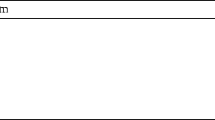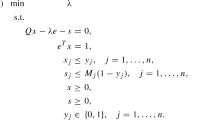Abstract
Linear programming with linear complementarity constraints (LPLCC) is an area of active research in Optimization, due to its many applications, algorithms, and theoretical existence results. In this paper, a number of formulations for important nonconvex optimization problems are first reviewed. The most relevant algorithms for computing a complementary feasible solution, a stationary point, and a global minimum for the LPLCC are also surveyed, together with some comments about their efficiency and efficacy in practice.
Similar content being viewed by others
References
Al-Khayyal F (1987) An implicit enumeration procedure for the general linear complementarity problem. Math Program Stud 31:1–20
Anitescu M (2005) On using the elastic mode in nonlinear programming approaches to mathematical programs with complementarity constraints. SIAM J Optim 15:1203–1236
Anitescu M, Tseng P, Wright SJ (2007) Elastic-mode algorithms for mathematical programs with equilibrium constraints: global convergence and stationarity properties. Math Program 110:337–371
Audet C, Hansen P, Jaumard B, Savard G (1999) A symmetrical linear maxmin approach to disjoint bilinear programming. Math Program 85:573–592
Audet C, Savard G, Zghal W (2007) New branch-and-cut algorithm for bilevel linear programming. J Optim Theory Appl 134:353–370
Bard J (1999) Practical bilevel optimization: algorithms and applications. Kluwer Academic, Dordrecht
Bard J, Moore J (1990) A branch and bound algorithm for the bilevel programming problem. SIAM J Sci Stat Comput 11:281–292
Bazaraa M, Sherali H, Shetty C (2006) Nonlinear programming: theory and algorithms, 3rd edn. Wiley, New York
Benson H, Sen A, Shanno D, Vanderbei R (2005) Interior-point algorithms, penalty methods and equilibrium problems. Comput Optim Appl 34:155–182
Burer S, Vandenbussche D (2008) A finite branch-and-bound algorithm for nonconvex quadratic programming via semidefinite relaxations. Math Program, Ser A 113:259–282
Colson B, Marcotte P, Savard G (2005) Bilevel programming: a survey. 4OR 3:87–107
Cottle R, Pang J-S, Stone R (1992) The linear complementarity problem. Academic Press, New York
de Sabóia CHM, Campêlo M, Scheimberg S (2004) A computational study of global algorithms for linear bilevel programming. Numer Algorithms 35:155–173
Dempe S (2002) Foundations of bilevel programming. Kluwer Academic, Dordrecht
Dirkse S, Ferris M, Meeraus A (2005) Mathematical programs with equilibrium constraints: automatic reformulation and solution via constrained optimization. In: Kehoe T, Srinivasan T, Whalley J (eds) Frontiers in applied general equilibrium modeling. Cambridge University Press, Cambridge, pp 67–93
Facchinei F, Jiang H, Qi L (1999) A smoothing method for mathematical programs with equilibrium constraints. Math Program 85:107–134
Fang HR, Leyffer S, Munson T (2009) A pivoting algorithm for linear programming with linear complementarity constraints. Optim Methods Softw (to appear). http://www.mcs.anl.gov/uploads/cels/papers/P1680.pdf
Fernandes L, Friedlander A, Guedes MC, Júdice J (2001) Solution of a general linear complementarity problem using smooth optimization and its application to bilinear programming and LCP. Appl Math Optim 43:1–19
Fletcher R, Leyffer S (2004) Solving mathematical programs with complementarity constraints as nonlinear programs. Optim Methods Softw 19:15–40
Fletcher R, Leyffer S, Ralph D, Scholtes S (2006) Local convergence of SQP methods for mathematical programs with equilibrium constraints. SIAM J Optim 17:259–286
Fukushima M, Tseng P (2002) An implementable active-set algorithm for computing a B-stationary point of the mathematical program with linear complementarity constraints. SIAM J Optim 12:724–739
Fukushima M, Luo Z-Q, Pang J-S (1998) A globally convergent sequential quadratic programming algorithm for mathematical programs with linear complementarity constraints. Comput Optim Appl 10:5–34
Gill P, Murray W, Wright M (1981) Practical optimization. Academic Press, London
Gümüz ZH, Floudas CA (2005) Global optimization of mixed-integer bilevel programming problems. Comput Manag Sci 2:181–212
Hansen P, Jaumard B, Savard G (1992) New branch-and-bound rules for linear bilevel programming. SIAM J Sci Stat Comput 13:1194–1217
Hu XM, Ralph D (2004) Convergence of a penalty method for mathematical programming with complementarity constraints. J Optim Theory Appl 123:365–390
Hu J, Mitchell JE, Pang J-S, Bennett KP, Kunapuli G (2008) On the global solution of linear programs with linear complementarity constraints. SIAM J Optim 19:445–471
Hu J, Mitchell J, Pang J-S (2010) An LPCC approach to nonconvex quadratic programs. Math. Program. (to appear). doi:10.1007/s10107-010-0426-y
Ibaraki T (1971) Complementary programming. Oper Res 19:1523–1529
Jeroslow RG (1978) Cutting-planes for complementarity constraints. SIAM J Control Optim 16:56–62
Jiang H, Ralph D (1999) Smooth SQP methods for mathematical programs with nonlinear complementarity constraints. SIAM J Optim 10:779–808
Jiang H, Ralph D (2003) Extension of quasi-Newton methods to mathematical programs with complementarity constraints Comput Optim Appl 25:123–150
Júdice J, Faustino A (1988) An experimental investigation of enumerative methods for the linear complementarity problem. Comput Oper Res 15:417–426
Júdice J, Faustino A (1991) A computational analysis of LCP methods for bilinear and concave quadratic programming. Comput Oper Res 18:645–654
Júdice J, Faustino A (1992) A SLCP method for bilevel linear programming. Ann Oper Res 34:89–106
Júdice J, Faustino A (1994) The linear-quadratic bilevel programming problem. Inf Syst Oper Res 32:87–98
Júdice JJ, Vicente LN (1994) On the solution and complexity of a generalized linear complementarity problem. J Glob Optim 4:415–424
Júdice J, Sherali H, Ribeiro I, Faustino A (2006) A complementarity-based partitioning and disjunctive cut algorithm for mathematical programming problems with equilibrium constraints. J Glob Optim 136:89–114
Júdice J, Sherali H, Ribeiro I, Faustino A (2007) A complementarity active-set algorithm for mathematical programming problems with equilibrium constraints. J Optim Theory Appl 136:467–481
Konno H (1971) Bilinear programming: Part II—applications of bilinear programming. Technical Report, Department of Operations Research, Stanford University
Le Thi H, Pham Dinh T (2005) The DC (difference of convex functions) programming and DCA revisited with DC models of real world nonconvex optimization problems. Ann Oper Res 133:23–46
Le Thi H, Pham Dinh T (2011) On solving linear complementarity problems by DC programming and DCA. Comput Optim Appl (to appear). doi:10.1007/s10589-011-9398-y
Leyffer S, López-calva G, Nocedal J (2004) Interior methods for mathematical programs with complementarity constraints. SIAM J Optim 17:52–77
Luo Z, Pang J-S, Ralph D (1997) Mathematical programs with equilibrium constraints. Cambridge University Press, New York
Mangasarian OL (1995) The linear complementarity problem as a separable bilinear program. J Glob Optim 6:153–161
Mangasarian OL (2007) Absolute value programming. Comput Optim Appl 36:43–53
Murtagh B, Saunders A (1983) MINOS 5.0 user’s guide. Technical Report SOL 83-20, Department of Operations Research, Stanford University
Murty K (1976) Linear and combinatorial programming. Wiley, New York
Murty K (1988) Linear complementarity, linear and nonlinear programming. Heldermann, Berlin
Nocedal J, Wright SJ (2006) Numerical optimization. Springer, Berlin
Outrata J, Kocvara M, Zowe J (1998) Nonsmooth approach to optimization problems with equilibrium constraints: theory, applications and numerical results. Kluwer Academic, Boston
Pang J-S, Fukushima M (1999) Complementarity constraint qualifications and simplified B-stationarity conditions for mathematical programs with equilibrium constraints. Comput Optim Appl 13:111–136
Ralph D (2008) Nonlinear programming advances in mathematical programming with complementarity constraints. R Soc (submitted). http://www.eng.cam.ac.uk/wdr241/Papers/MPCC-review.pdf
Sahinidis NV, Tawarmalani M (2005) BARON 7.2.5: global optimization of mixed-integer nonlinear programs. User’s Manual
Scheel H, Scholtes S (2000) Mathematical programs with complementarity constraints: stationarity, optimality and sensitivity. Math Oper Res 25:1–22
Scholtes S (1999) Active set methods for inverse linear complementarity problems. Technical Report, Judge Institute of Management Research
Scholtes S (2000) Convergence properties of a regularization scheme for mathematical programs with complementarity constraints. SIAM J Optim 11:918–936
Sherali HD, Adams WP (1999) A reformulation-linearization technique for solving discrete and continuous nonconvex problems. Kluwer Academic, Dordrecht
Sherali HD, Krishnamurthy RS, Al-Khayyal FA (1998) Enumeration approach for linear complementarity problems based on a reformulation-linearization technique. J Optim Theory Appl 99:481–507
Tawarmalani M, Sahinidis NV (2004) Global optimization of mixed-integer nonlinear programs: a theoretical and computational study. Math Program 99:563–591
Vandenbussche D, Nemhauser G (2005) A branch-and-cut algorithm for nonconvex quadratic programs with box constraints. Math Program, Ser A 102:559–575
Ye JJ (1999) Optimality conditions for optimization problems with complementarity constraints. SIAM J Optim 9:374–387
Ye JJ (2005) Necessary and sufficient optimality conditions for mathematical programs with equilibrium constraints. J Math Anal Appl 307:350–369
Ye Y (1993) A fully polynomial-time approximation algorithm for computing a stationary point of the general linear complementarity problem. Math Oper Res 18:334–345
Author information
Authors and Affiliations
Corresponding author
Rights and permissions
About this article
Cite this article
Júdice, J.J. Algorithms for linear programming with linear complementarity constraints. TOP 20, 4–25 (2012). https://doi.org/10.1007/s11750-011-0228-2
Published:
Issue Date:
DOI: https://doi.org/10.1007/s11750-011-0228-2
Keywords
- Complementarity problems
- Global optimization
- Nonlinear programming
- Mathematical programming with linear complementarity constraints




